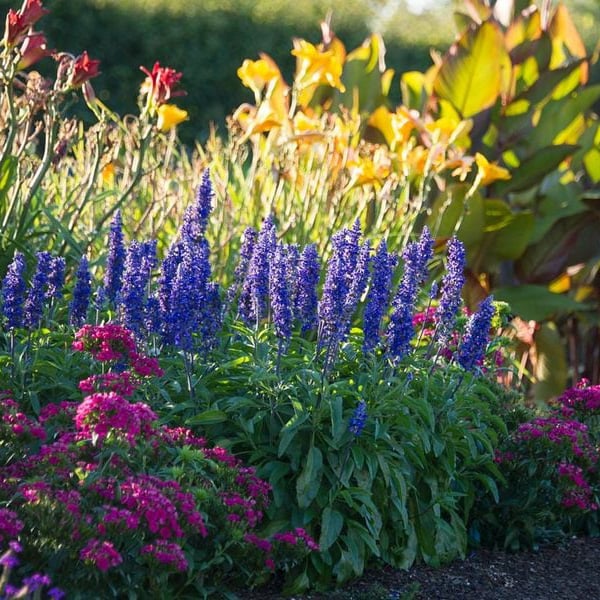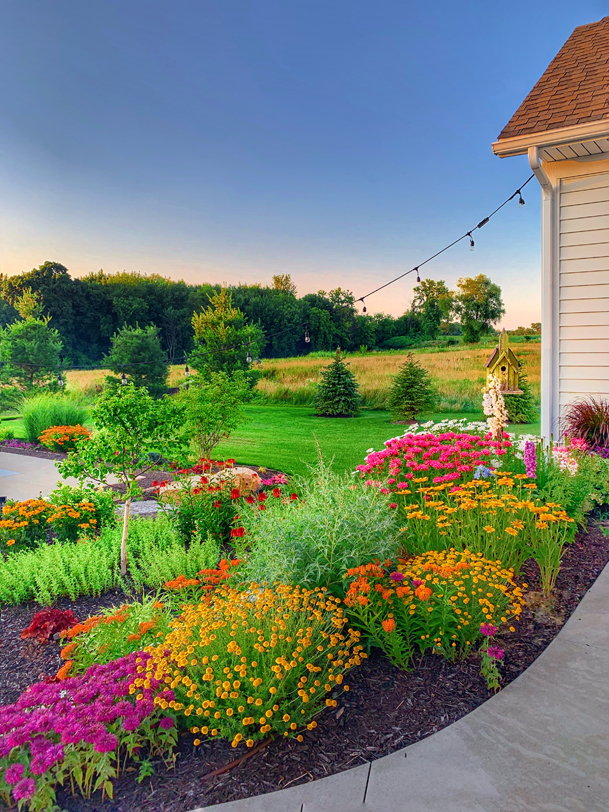Designing a garden bed can seem overwhelming at first. But with the right steps, it becomes an enjoyable task.
A well-designed garden bed brings beauty and life to your outdoor space. It can also boost your home’s curb appeal. Whether you’re an experienced gardener or a newbie, knowing how to plan and set up a garden bed makes a big difference.
You’ll need to consider the layout, plant choices, and soil conditions. This guide will walk you through each step, making the process simple and fun. Get ready to transform your garden into a vibrant, thriving space. Let’s dig in and start creating your dream garden bed!
Choosing The Right Location
Designing a garden bed starts with choosing the right location. A well-chosen spot ensures your plants get the right amount of sunlight, drainage, and soil composition they need to thrive. This step is crucial for your garden bed layout, depth, and overall garden aesthetics. Let’s explore how to select the perfect location for your garden bed.
Sunlight Requirements
Sunlight is essential for plant growth. Most vegetables and flowers need at least six hours of direct sunlight each day. When planning your garden bed layout, observe your yard to identify sunny spots.
Consider these tips:
- Full Sun: Choose a location that gets full sun for sun-loving plants like tomatoes and sunflowers.
- Partial Shade: Some plants, such as leafy greens, thrive in partial shade. Look for areas with filtered sunlight.
- Seasonal Planting: Remember that sunlight patterns change with seasons. Plan your garden bed layout to accommodate seasonal planting.
Here’s a table to help you understand the sunlight needs of common plants:
| Plant | Sunlight Needs |
|---|---|
| Tomatoes | Full Sun (6+ hours) |
| Lettuce | Partial Shade (3-4 hours) |
| Carrots | Full Sun (6+ hours) |
| Spinach | Partial Shade (3-4 hours) |
Ensure that your garden bed location meets the sunlight requirements of your chosen plants. This will help in achieving a balanced planting design and successful garden maintenance.
Drainage Considerations
Proper drainage is vital for plant health. Waterlogged soil can lead to root rot and other issues. When selecting your garden bed location, consider the natural drainage of the area.
Follow these steps to assess drainage:
- Observe after Rain: Check the area after a heavy rain. If water pools, the spot has poor drainage.
- Soil Composition: Test the soil. Sandy soil drains well, while clay soil retains water.
- Raised Garden Beds: For areas with poor drainage, consider using raised garden beds. These can improve drainage and soil composition.
Improving drainage can be achieved by:
- Adding Organic Matter: Mix compost into the soil to enhance drainage.
- Creating Slopes: Slightly slope the garden bed to help water flow away.
- Using Gravel Layers: Place gravel at the bottom of the bed to facilitate better drainage.
Proper drainage ensures healthy roots and thriving plants. It also simplifies garden maintenance and supports companion planting by preventing water-related issues.
Selecting Materials
Designing a garden bed involves many exciting steps, one of which is selecting the right materials. The materials you choose will affect the durability, appearance, and cost of your garden bed. In this section, we will explore different options available, helping you make an informed decision for your flower bed ideas and overall garden layout.
Wood Options
Wood is a popular choice for garden bed materials due to its natural look and ease of use. There are several types of wood to consider:
- Cedar: Cedar is a durable wood that resists rot and insects. It is a bit pricier but lasts longer.
- Pine: Pine is more affordable but less durable. It may need treatments to extend its life.
- Redwood: Redwood is another durable option, known for its rich color and resistance to decay.
Using wood for your raised garden beds can give a classic look to your landscape design. Here is a quick comparison:
| Wood Type | Durability | Cost |
|---|---|---|
| Cedar | High | High |
| Pine | Medium | Low |
| Redwood | High | High |
When using wood, ensure it is untreated to avoid harmful chemicals leaching into the soil. Proper soil preparation and regular maintenance can prolong the life of wooden garden beds.
Alternative Materials
Beyond wood, there are many alternative materials for garden bed design. These materials can offer unique benefits:
- Metal: Metal garden beds, often made of galvanized steel, are durable and have a modern look. They resist pests and rot.
- Concrete Blocks: Concrete blocks are sturdy and affordable. They provide excellent insulation for soil temperature control.
- Stone: Stone is a natural, long-lasting material. It can create a rustic or elegant appearance in your garden layout.
- Recycled Plastic: Recycled plastic boards are eco-friendly and require minimal maintenance. They do not rot or attract pests.
Here’s a brief comparison of these alternative materials:
| Material | Durability | Cost |
|---|---|---|
| Metal | High | Medium |
| Concrete Blocks | High | Low |
| Stone | High | High |
| Recycled Plastic | High | Medium |
Choosing the right material for your garden bed involves considering factors like durability, cost, and the overall aesthetic you want for your garden. Each material has unique benefits that can enhance your gardening techniques and planting strategies, whether you are focusing on a vegetable garden or decorative flower beds.
How to Design a Garden Bed?
Best Book in garden design : Bed Garden Design Project: Step-By-Step Guide To Building A Bed Garden: Raised Bed Gardening For Beginners, Check Price at Amazon
Determining Size And Shape
Creating the perfect garden bed begins with determining the size and shape. The design choices can impact the health of plants and the aesthetics of your outdoor space. Understanding the various options will help you create a garden bed that suits your needs and complements your garden layout.
Standard Dimensions
When planning your garden bed design, standard dimensions can simplify the process. The typical width for garden beds ranges from 3 to 4 feet. This width allows easy access to plants without stepping on the soil, which is crucial for soil preparation and plant health.
Here are some common dimensions:
- 3 feet wide: Ideal for narrow spaces, allows access from both sides.
- 4 feet wide: Suitable for larger areas, provides ample planting space while maintaining accessibility.
Length can vary based on your space and preference. Standard lengths usually range from 6 to 12 feet. Raised garden beds often follow these dimensions for convenience and efficiency.
Consider these factors when deciding on dimensions:
| Factor | Consideration |
|---|---|
| Space Available | Measure your available area to ensure a good fit. |
| Planting Zones | Choose dimensions that suit the types of plants you want to grow. |
| Garden Bed Accessibility | Ensure you can reach all plants for maintenance and harvesting. |
A well-planned garden bed design with standard dimensions can enhance your landscaping ideas and make garden maintenance easier.
Creative Shapes
For a unique garden layout, consider creative shapes. Garden beds don’t have to be rectangular. They can be circular, L-shaped, or even freeform. These shapes can add visual interest and help utilize awkward spaces.
Here are some creative shapes to consider:
- Circular Beds: Great for focal points, easy to access from all sides.
- L-shaped Beds: Fit well in corners, maximize space usage.
- Freeform Beds: Adapt to any space, allow creativity in design.
Creative shapes can also enhance flower bed arrangements. For example, a spiral herb garden can add a dynamic element to your garden bed design. Use different garden bed materials like bricks, wood, or stones to define the shapes and add texture.
Consider these tips for creative shapes:
- Visual Appeal: Choose shapes that complement your garden’s aesthetic.
- Functionality: Ensure the shape allows for easy access and maintenance.
- Soil Preparation: Plan shapes that facilitate proper soil drainage and root growth.
Experimenting with creative shapes can transform your vegetable garden design and make your outdoor space more engaging and enjoyable.
Soil Preparation
Designing a garden bed involves several important steps, and one of the most crucial is soil preparation. Proper soil preparation ensures your plants get the nutrients they need to thrive. Without good soil, even the best garden design tips won’t lead to a healthy garden. Let’s dive into the essentials of preparing your soil, starting with testing its quality and then amending it as needed.
Testing Soil Quality
Before you start planting, it’s essential to test your soil quality. This step helps you understand what nutrients your soil might be lacking and how to amend it properly. Here are some garden design tips to help you test your soil:
- Soil pH Testing: Soil pH affects how well plants can absorb nutrients. You can buy a soil pH testing kit at most garden centers.
- Texture Analysis: Check if your soil is sandy, clay, or loamy. Each type has different drainage solutions and nutrient retention capabilities.
- Organic Matter: Measure the amount of organic material in your soil. High organic content improves soil structure and fertility.
Performing these tests will give you a clear picture of your soil’s health. You can also send a soil sample to a local extension office for a more detailed analysis. Here’s a simple table to help you understand what different pH levels mean:
| pH Level | Soil Type | Plant Suitability |
|---|---|---|
| Below 6.0 | Acidic | Azaleas, Blueberries |
| 6.0 – 7.0 | Neutral | Most Vegetables |
| Above 7.0 | Alkaline | Lavender, Spinach |
Understanding your soil’s pH and quality will guide your decisions on plant selection and garden bed layout. Once you know what your soil needs, you can move on to amending it to create the perfect growing environment.
Amending Soil
After testing, the next step is amending your soil to enhance its quality. Amending involves adding materials to improve texture, nutrient content, and drainage. Here are some key organic soil amendments to consider:
- Compost: Adds organic matter, improves soil structure, and provides essential nutrients.
- Manure: Rich in nutrients but should be well-rotted to avoid burning plants.
- Peat Moss: Helps retain moisture in sandy soils and improves drainage in clay soils.
For raised garden beds, it’s important to fill them with a mixture of topsoil and compost. This ensures that plants have access to nutrients and proper drainage. Consider the following table for a balanced soil amendment mix:
| Component | Proportion |
|---|---|
| Topsoil | 60% |
| Compost | 30% |
| Peat Moss | 10% |
Using these proportions, you can create a fertile base for your garden bed. Remember, different plants have unique requirements. Seasonal planting and companion planting can help optimize your garden bed layout. Adding the right amendments will ensure your plants get the best start.
Plant Selection
Designing a garden bed is an exciting and rewarding project. One of the most important aspects of creating a successful garden is plant selection. Choosing the right plants for your garden bed can influence its beauty, health, and productivity. Let’s dive into the details of plant selection, focusing on seasonal plants and companion planting.
Seasonal Plants
Understanding the planting season is crucial for a thriving garden. Seasonal plants adapt to the changing climate and ensure your garden bed stays vibrant throughout the year. Here are some key tips for choosing seasonal plants:
- Spring: Consider planting tulips, daffodils, and pansies. These flowers bring color and fragrance to your garden bed.
- Summer: Opt for sun-loving plants like marigolds, zinnias, and tomatoes. These plants thrive in the warm weather.
- Fall: Mums, asters, and kale are excellent choices. They add beauty and withstand cooler temperatures.
- Winter: Evergreens, holly, and winter pansies keep your garden bed lively even in the cold months.
Here’s a simple table to help with seasonal plant selection:
| Season | Plant Types |
|---|---|
| Spring | Tulips, Daffodils, Pansies |
| Summer | Marigolds, Zinnias, Tomatoes |
| Fall | Mums, Asters, Kale |
| Winter | Evergreens, Holly, Winter Pansies |
Choosing seasonal plants ensures that your garden bed layout remains attractive and productive all year round. It also aids in soil preparation and reduces the need for frequent garden maintenance.
Companion Planting
Companion planting is an effective garden design idea. This technique involves planting different crops close to each other for mutual benefit. It can improve plant health, deter pests, and enhance garden aesthetics. Here are some popular companion planting combinations:
- Tomatoes and Basil: Basil repels pests that harm tomatoes. This duo is perfect for a vegetable garden planning.
- Carrots and Onions: Onions deter carrot flies, while carrots help onions by loosening the soil.
- Beans and Corn: Beans fix nitrogen in the soil, which benefits the corn. Corn provides support for the bean vines.
- Roses and Garlic: Garlic protects roses from aphids and other pests, enhancing flower bed design.
Companion planting also aids in efficient plant spacing. Proper spacing prevents overcrowding and ensures each plant gets enough nutrients, water, and sunlight. Here’s a quick overview:
| Companion Plants | Benefits |
|---|---|
| Tomatoes and Basil | Pest control, enhanced flavor |
| Carrots and Onions | Pest deterrent, soil improvement |
| Beans and Corn | Nitrogen fixation, structural support |
| Roses and Garlic | Pest protection, improved growth |
Using companion planting in your raised garden beds can simplify garden maintenance and improve overall plant health. It’s a practical approach for both novice and experienced gardeners looking to optimize their garden bed layout.

Credit: www.gardenary.com
Watering Strategies
Designing a garden bed involves several steps, and one of the most crucial is establishing effective watering strategies. Proper watering ensures your plants thrive, contributing to the overall health and beauty of your garden. Let’s explore two essential watering strategies: irrigation systems and manual watering tips.
Irrigation Systems
Irrigation systems offer an efficient way to water your garden beds, ensuring consistent moisture levels. These systems can save time and water, making them ideal for sustainable gardening. Here are some popular irrigation techniques:
- Drip Irrigation: This system delivers water directly to the plant roots, reducing evaporation and runoff. It’s perfect for raised garden beds and areas with specific planting designs.
- Soaker Hoses: These hoses release water slowly along their length, ideal for garden layouts with dense planting. They are easy to install and can be buried under mulch to maintain garden aesthetics.
- Sprinkler Systems: Suitable for larger garden areas, sprinklers cover a wide area evenly. Ensure you adjust them to avoid overwatering and water wastage.
When choosing an irrigation system, consider your garden’s soil preparation, plant selection, and landscape planning. Automated systems with timers can further enhance garden maintenance, ensuring your plants receive water even when you’re away.
Manual Watering Tips
Manual watering is a hands-on approach, allowing you to monitor your plants closely. Here are some tips to make manual watering effective:
- Water Early or Late: Water your garden early in the morning or late in the evening. This reduces evaporation and helps plants absorb more water.
- Use a Watering Can or Hose: A watering can or hose with a spray attachment can help you direct water to the base of each plant. This prevents wetting the foliage, which can lead to diseases.
- Check Soil Moisture: Before watering, check the soil moisture. Insert your finger about an inch into the soil. If it feels dry, it’s time to water.
- Water Deeply: Water deeply and less frequently. This encourages plants to develop deep root systems, improving their resilience.
Manual watering also allows you to adjust based on weather conditions and plant needs. It’s a simple and effective way to maintain your garden’s health and appearance.
Maintaining The Garden Bed
Designing a garden bed requires thoughtful planning and execution. Once the garden bed is set, maintaining it is essential to ensure your plants thrive. Proper garden bed maintenance involves several key practices that will keep your garden healthy and beautiful throughout the seasons.
Weed Control
Weed control is crucial for maintaining a garden bed. Weeds compete with your plants for nutrients, water, and light. Regular weeding helps your plants grow stronger and healthier. Here are some effective strategies for weed control:
- Mulch Application: Apply a layer of mulch around your plants. Mulch helps to suppress weed growth by blocking sunlight. It also retains moisture and improves soil quality.
- Hand Weeding: Remove weeds by hand, especially before they set seed. This is an effective way to control weeds in smaller garden beds.
- Use of Weed Barriers: Install weed barriers or landscape fabric under the mulch. This prevents weeds from emerging while allowing water and nutrients to reach your plants.
- Proper Spacing: Follow recommended plant spacing guidelines in your garden bed layout. Crowded plants can encourage weed growth, making it harder to maintain your garden.
Weed control should be a regular part of your garden bed maintenance routine. Consistent efforts will keep weeds at bay and ensure your plants have the best environment to flourish.
Fertilization Techniques
Fertilization is essential for providing the nutrients your plants need to grow. Different plants have varied nutrient requirements, so understanding the right fertilization techniques is key:
Soil Preparation: Before planting, test your soil to determine its nutrient levels. Add organic matter like compost to improve soil structure and fertility.
Organic Gardening: Use organic fertilizers such as compost, manure, or bone meal. Organic fertilizers release nutrients slowly, providing a steady supply to your plants.
Seasonal Planting Guides: Follow seasonal planting guides to know the best times to fertilize different plants. For example, many plants benefit from fertilization in early spring and mid-summer.
| Fertilizer Type | Best Used For |
|---|---|
| Compost | General soil improvement and nutrient supply |
| Bone Meal | Root development and flowering plants |
| Manure | Improving soil structure and slow-release nutrients |
Companion Planting: Planting certain plants together can improve soil health and reduce the need for fertilizers. For example, legumes fix nitrogen in the soil, benefiting nearby plants.
Raised Garden Beds: Raised garden beds can improve drainage and reduce soil compaction. This creates a better environment for your plants to absorb nutrients.
Effective fertilization techniques ensure your plants get the nutrients they need. This supports their growth and helps them resist pests and diseases.

Credit: www.whiteflowerfarm.com
Seasonal Adjustments
Designing a garden bed involves more than just planting flowers or vegetables. Seasonal adjustments play a key role in keeping your garden thriving throughout the year. Understanding how to prepare your garden bed for different seasons ensures that your plants receive the care they need to flourish. Let’s explore some essential tips for winter preparations and summer care.
Winter Preparations
Winter brings challenges that require specific garden design principles to safeguard your plants. Preparing your garden bed for winter involves several critical steps:
- Soil Preparation: Before the first frost, enrich your soil with organic matter. This helps retain moisture and provides nutrients during the cold months.
- Plant Selection: Choose hardy perennials and winter vegetables that can withstand lower temperatures. Consider plants like kale, spinach, and pansies.
- Garden Bed Layout: Use raised garden beds to improve drainage. This prevents waterlogging, which can damage plant roots in winter.
- Mulching: Apply a thick layer of mulch to insulate the soil. Mulch keeps the soil temperature stable and protects roots from freezing.
Consider a simple table for winter care tasks:
| Task | Details |
|---|---|
| Soil Preparation | Enrich with compost or organic matter |
| Plant Selection | Choose cold-hardy plants |
| Garden Bed Layout | Use raised beds for better drainage |
| Mulching | Apply a thick layer of mulch |
Protecting your garden bed in winter ensures a healthy start for the next growing season. Implementing these seasonal gardening tips helps maintain garden maintenance efficiently.
Summer Care
Summer poses its own set of challenges, with heat and dryness being primary concerns. Effective summer care involves adapting your planting techniques and irrigation methods:
- Irrigation Methods: Install drip irrigation systems to provide consistent moisture. Water early in the morning to reduce evaporation.
- Companion Planting: Use companion planting to maximize space and reduce pests. Marigolds, for example, deter many insects.
- Soil Preparation: Maintain soil health by adding organic mulch. It conserves moisture and keeps roots cool.
- Plant Selection: Opt for drought-tolerant plants like succulents and lavender. These plants require less water and thrive in hot conditions.
A table for summer care tasks can be helpful:
| Task | Details |
|---|---|
| Irrigation Methods | Install drip irrigation, water in the morning |
| Companion Planting | Use plants that deter pests |
| Soil Preparation | Add organic mulch |
| Plant Selection | Choose drought-tolerant plants |
Maintaining your garden bed during summer ensures that your plants stay healthy and productive. These garden maintenance practices keep your garden flourishing despite the heat.

Credit: plaidsandpoppies.com
Frequently Asked Questions
What Is The Best Soil For A Garden Bed?
The best soil for a garden bed is loamy soil. Loamy soil contains a balance of sand, silt, and clay. It ensures good drainage and nutrient retention.
How Deep Should A Garden Bed Be?
A garden bed should be at least 6-12 inches deep. Deeper beds allow better root growth and water retention.
How To Choose Plants For A Garden Bed?
Choose plants based on sunlight, soil type, and climate. Consider plant height and spacing for optimal growth.
What Tools Do I Need For Garden Bed Design?
You need a shovel, rake, trowel, and gardening gloves. These tools help with digging, leveling, and planting.
Conclusion
Creating a garden bed can be simple and fun. Start small. Choose plants that you like. Plan the layout carefully. Consider sunlight and soil needs. Remember to water and maintain it. Enjoy the process and watch your garden flourish. Happy gardening!

My name is Mahi Uddin, and I’m a blog writer with over two years of experience specializing in creating engaging, informative content using AI tools. I contribute to InExDecor.com, where I share creative ideas and practical tips for transforming interior and exterior spaces into beautiful, functional environments. With a passion for storytelling and a knack for blending creativity with technology, I strive to craft blogs that not only inform but also inspire readers. When I’m not writing, you can find me exploring design trends or enjoying a good book with a cup of coffee.








